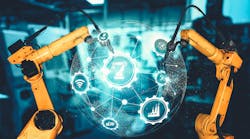Not long ago, the words “Wouldn’t it be great if…” reverberated around the walls of manufacturing and production environments. Organizations have long known that in the future, digital transformation would be essential to competitiveness.
Enter the past two years. Spurred by a global pandemic, massive supply chain challenges, skills gaps, and labor shortages, some companies are realizing that dabbling in technology adoption won’t be enough not only to compete but even to survive. They have to go all in.
Now we’re at an inflection point. Here are five smart factory predictions for 2022, “The Year of the Smart Factory.”
1. Manufacturing will move from occasional smart factory use cases to full-scale smart factory adoption: Before now, a truly smart factory with integrated solutions has been elusive due to gaps in offerings without providers to meet all of the technology needs to make a smart factory a reality. But technology has now become more cost-effective with hundreds of start-ups entering the game.
Technology and solutions such as video analytics, artificial intelligence, cybersecurity, autonomous mobile robots, and command centers that used to require custom and often home-grown solutions are now offered by multiple providers. There are multiple options for every piece of the technology puzzle.
Now that we have integrated smart factory solutions, I predict we’ll see a big evolution from organizations having a couple of smart factory components to whole production environments becoming smart.
2. Organizations will be driven by FOMO. The Fear of Missing Out will be a big driver of smart factory adoption in 2022. Organizations are increasingly understanding that avoiding digital transformation is not an option and that they may no longer be competitive if they don’t jump in now. They will be more open to big changes that can deliver big outcomes.
3. Big data will take center stage. Manufacturers are becoming more comfortable with big data, which is what makes a smart factory work. True smart factories will have command centers—think multiple control towers—that bring together data from across the organization in ways that companies have never been able to do before. Most importantly, organizations will have ways to act on the data, bringing technology and humans together. The intersection of the command center and humans will lead to true business transformation.
4. Vision systems and autonomous mobile robots will play big smart factory roles. With material costs skyrocketing, organizations cannot afford quality errors. Vision systems will become increasingly essential in quickly identifying mistakes or defects before they impact the whole production line. This will lead to significant improvements in quality and safety and play a big role in lean transformation.
Another key technology will be autonomous mobile robots (AMRs), which have the power to create huge efficiencies by automating repetitive tasks. Whereas today a company might have a few dozen replenishment specialists on a line, that could go down to zero in the near future.
It’s important to point out that these technologies do not replace the important role of people—in fact, they make humans that much more essential by allowing them to focus on their uniquely human skills that drive business value.
5. The manufacturing labor shortage will get worse before it gets better. For at least the next two years, the labor shortage will persist and likely worsen before it gets better. This will make technology adoption more critical to ensure that companies can continue to operate and meet customer demands. In addition to smart factory adoption, organizations can get ahead by understanding how critical manufacturing roles will evolve and how to better hire, train, reskill and upskill for these roles.
Every manufacturer should ask themselves if they are ready for The Year of the Smart Factory. If the answer is no, a little FOMO and a lot of due diligence about their smart factory opportunities could be all they need to get started—and get ahead.











